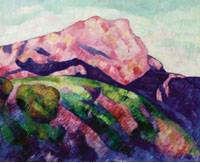 In early September, I visited the Montclair Art Museum to see its Cezanne and American Modernism exhibition, and I came away an even bigger fan of … Marsden Hartley.
In early September, I visited the Montclair Art Museum to see its Cezanne and American Modernism exhibition, and I came away an even bigger fan of … Marsden Hartley.
And now I can talk about it, because my review of the show is now published, in today’s Wall Street Journal. (I had already written once about this exhibit, in July, when curator Gail Stavitsky answered Five Questions from me. But then, I hadn’t seen it.)
 Of course, Cezanne is the master, but in an exhibit like this — which tries to show his influence on 34 American artists, including photographers like Steichen and Stieglitz, and Western artists — his works are not a revelation. So, instead of playing the game of “which work would I take home if I had my choice of one,” I instead tried to decide which disciple of Cezanne in this crop came out the best.
Of course, Cezanne is the master, but in an exhibit like this — which tries to show his influence on 34 American artists, including photographers like Steichen and Stieglitz, and Western artists — his works are not a revelation. So, instead of playing the game of “which work would I take home if I had my choice of one,” I instead tried to decide which disciple of Cezanne in this crop came out the best.
And it has to be Hartley. Stavitsky said in July that he was the one in the exhibit on whom Cezanne had the most influence, but that held no sway with me. I chose Hartley because, as I wrote for the WSJ, “he emerges his own man.” Viewers can see how Hartley learned, by imitating, yet — knowing his later works — also developed his own style. The two Hartley works here, a view of Mont Sainte-Victoire (there’s another on my July post) and a painting from Vence that is not in this exhibit but is much like one that is (I could not obtain an image of it), are from the late 1920s. Hartley had many more years of work ahead.
As my review implies, not all the artists in Cezanne and American Modernism rose above homage and imitation. Go anyway: this story needed to be told, even if it’s not all happy endings.
